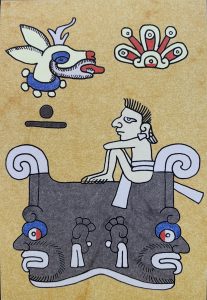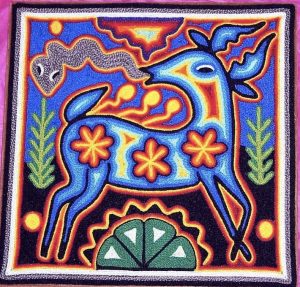 During this year’s early muzzleloader mule deer hunt I learned a lot about stalking deer and managed to get within 30-40 yards of a bedded down buck after a very long stalk. I had spotted this deer from over a mile away at just the time it was getting ready to bed down. I’d already blown two stalks where I only had gotten to about 100 yards from the animal and this time I was very careful and managed to get much closer. I just forgot one final part in the process of stalking a deer and took one step too many busting the deer but still it was an experience I probably won’t forget and I learned many lessons from it. I’m now getting ready for late season and was thinking back on the early season hunt and the things I need to remember later this month to be successful.
During this year’s early muzzleloader mule deer hunt I learned a lot about stalking deer and managed to get within 30-40 yards of a bedded down buck after a very long stalk. I had spotted this deer from over a mile away at just the time it was getting ready to bed down. I’d already blown two stalks where I only had gotten to about 100 yards from the animal and this time I was very careful and managed to get much closer. I just forgot one final part in the process of stalking a deer and took one step too many busting the deer but still it was an experience I probably won’t forget and I learned many lessons from it. I’m now getting ready for late season and was thinking back on the early season hunt and the things I need to remember later this month to be successful.
As I was reflecting on my hunt I began to wonder what the relationship was between stalking a deer and stalking in the Toltec tradition. Years ago I did a year long apprenticeship within the Toltec lineage of don Miguel Ruiz and had also worked with Victor Sanchez as well as being immersed in the works (now mostly debunked) of Carlos Castañeda. I knew there were two main practices within this tradition – that of dreaming and that of stalking. What could my hunt teach me about this stalking?
I went back and looked at The Teachings of don Carlos by Victor Sanchez and found a small section on Stalking and Hunting:
The term “stalking” naturally reminds us of hunting. A stalker is one who observes, one in whom stealth forms an integral part of conduct. A hunter is necessarily a stalker, although only warriors would be able to apply this technique to every aspect of their life, converting its every element, including self and personal weaknesses, into their prey.
The true hunter, as well as the stalker, well knows the difference between judgement and observation, between paying attention and thinking. If we wish to trap prey, we must first observe it. We must silently perceive what the prey does in order to know its routines: where it eats, when and what time it sleeps, its movements, and so forth. If our observation is effective, we will become familiar with these routines, allowing us to later devise a trap against them.”
This is exactly it, taking what I learned in stalking deer to stalking myself. Spot and stalk hunting consists of:
- Glassing from a high vantage point to find an animal
- Watching that animal to observe its behavior and hopefully watch it bed down
- Making a plan for a stalk (I got better with this after the first stalk which I rushed into without a good plan)
- Stealthily making the stalk, taking into account the topography and wind to get close to the animal ( I got better with this on the second stalk of the trip and executed it perfectly on the third stalk).
- Waiting for the animal to stand up (the step I missed on the last stalk) and taking the shot
Relating this to one’s own habits is pretty much the same. First one needs to realize that there is this habit or behavior that one wants to hunt, this is the first step of finding an animal. Next one must objectively watch the habit pattern and observe its behavior. What triggers this habit? What causes it to go away? What other effects does it have on your being? This is step 2. Now the warrior must devise a plan to arrest the habit. Then one must stalk the habit and be aware when it starts to manifest, get close the the habit or behavior. Finally one must be patient and wait before trapping the habit and stopping it.
Now what habit or behavior is being stalked? It can be any habit, behavior, thought pattern or addiction but it all comes down to one thing really – our self importance. Carlos Castañeda had this to say about stalking and hunting:
“The warrior who is stalking is a hunter. But, as opposed to an ordinary hunter who has his mind set on his material interests, the warrior pursues a bigger prey: His self-importance. That prepares him to face the challenge of dealing with his fellow men.”
This brings the art of stalking around to one of don Miguel’s Four Agreements – Don’t take anything personally. We all take things personally because we are full of self-importance. The stalker goes after that self-importance the way a hunter goes after game.
Castañeda went on to say:
“That kind of attention applied to an animal results in a hunting piece. If we apply it to another person, it produces a client, a pupil, or a romantic relationship. And applied to an inorganic being, it provides what sorcerers call ‘an ally’. But only if we apply stalking to ourselves, can it be considered a Toltec art, because it produces something precious: Awareness.”
 Interestingly I began to think about stalking again in relation to a deer hunt. I do a lot of hunting these days, mostly for birds and sometimes for elk but deer have always held a special place for me. Well, it turns out that this was an appropriate hunt for me to begin thinking about the art of stalking again. The deer is a very important figure in the Toltec tradition and is another representation of divinity. It is the main spiritual enticer that brings seekers to the path of knowledge.
Interestingly I began to think about stalking again in relation to a deer hunt. I do a lot of hunting these days, mostly for birds and sometimes for elk but deer have always held a special place for me. Well, it turns out that this was an appropriate hunt for me to begin thinking about the art of stalking again. The deer is a very important figure in the Toltec tradition and is another representation of divinity. It is the main spiritual enticer that brings seekers to the path of knowledge.
In the Huichol tradition there is the sacred blue deer, Tamatz Kahullumary. According to Victor Sanchez in The Toltec Oracle:
“..the blue deer, Masatl, represents the quest for spiritual vision. The deer will bring the vision as long as we undertake all the steps and tasks that must be accomplished before the deer will reveal itself.
… Masatl suggests spiritual initiation and awakening to a higher state of awareness. It is an omen and a call. It is up to you to find out how and when you will respond to that call.”
This re-kindling of interest in the Toltec tradition started last year with my late muzzleloader hunt when I more or less instinctively performed a ceremony before the hunt began using the power stick I had created years ago during the year long apprenticeship. I felt that hunting meat was a sacred activity and needed to be bounded in some way by moving into a sacred space. Now after this year’s hunt I see even more connection between the path of a hunter and the Toltec path of a warrior. I’m not sure where all this will lead ultimately but it is something to explore over the coming year.
